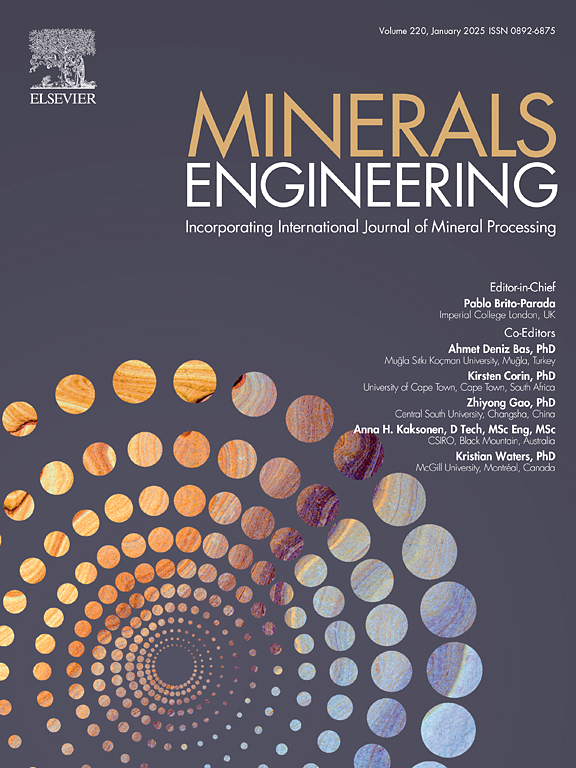利用电子效应对羟基肟酸进行改性的潜力:以强化锡石浮选为例
IF 5
2区 工程技术
Q1 ENGINEERING, CHEMICAL
引用次数: 0
摘要
尽管选择性突出,但提高羟肟酸的收集能力仍然是一个重大挑战。本研究从电子效应出发,在苯甲羟肟酸(BHA)骨架的基础上,通过双键延伸和对甲氧基的引入,设计合成了三种新型的羟肟酸:各向异性羟肟酸(AHA)、肉桂羟肟酸(CHA)和对甲氧基肉桂羟肟酸(PHA)。以锡石为研究对象,探讨了电子效应增强的羟肟酸对锡石捕收性能的影响。单矿物浮选试验结果表明,在相同的浮选剂量下,锡石的回收率依次递减:PHA >;CHA祝辞啊哈祝辞BHA,符合量子化学性质的预测。随后的研究表明,AHA的甲氧基不仅作为给电子基团,通过苯环共轭体系将电子传导到功能性羟肟酸基团上,还显著增强了捕集剂的疏水性,接触角测试证明了这一点。此外,FTIR和XPS分析表明,在CHA中加入不饱和键可以增强其在Sn4+活性位点的吸附强度,这得益于扩展共轭效应。AFM成像证实了上述结论,并确定PHA具有双键和对甲氧基特征,是锡石较好的捕收剂。与BHA相比,PHA作为双齿配体,在锡石(110)平面上表现出更紧凑的吸附构型,同时吸附能明显降低。综上所述,基于电子效应的羟肟酸改性策略是高效可行的,为提高难选氧化矿石的浮选性能提供了巨大的潜力。本文章由计算机程序翻译,如有差异,请以英文原文为准。
Potential for hydroxamic acid modification via electronic effect: A case study of enhanced cassiterite flotation
Despite the selectivity highlighting, the improvement of collecting capacity of hydroxamic acids remains a significant challenge. In this study, commencing from the electronic effect and based on the benzohydroxamic acid (BHA) skeleton, three novel hydroxamic acids, anisohydroxamic acid (AHA), cinnamohydroxamic acid (CHA), and p-methoxy cinnamohydroxamic acid (PHA), were designed and synthesized via double-bond extension and the introduction of a para-methoxy group. Taking cassiterite as the research subject, the impact of hydroxamic acids with enhanced electronic effect on the collecting performance was explored. Results of single-mineral flotation tests indicated that, with identical dosages, the cassiterite recovery decreased in the following order: PHA > CHA > AHA > BHA, aligning with the prediction derived from quantum chemical properties. Subsequent investigation revealed that the methoxy group of AHA not only served as an electron-donating moiety, conducting electrons to the functional hydroxamic acid group via the conjugated system of benzene ring, but also significantly enhance the hydrophobic property of the collector, as evidenced by the contact angle tests. Besides, FTIR and XPS analysis suggested that the incorporation of unsaturated bonds within CHA boosted its adsorption intensity at the Sn4+ active sites, benefiting from the extended conjugation effect. AFM imaging confirmed the above conclusions and determined that PHA, featuring both double bond and para-methoxy group, emerged as a preferable collector for cassiterite. In contrast to BHA, PHA, acting as a bidentate ligand, exhibited a more compact adsorption configuration on cassiterite (110) plane, accompanied by a significantly lower adsorption energy. Collectively, the hydroxamic acid modification strategy grounded in electronic effect proved to be highly efficient and viable, offering substantial potential for enhancing the flotation performance of refractory oxidized ores.
求助全文
通过发布文献求助,成功后即可免费获取论文全文。
去求助
来源期刊

Minerals Engineering
工程技术-工程:化工
CiteScore
8.70
自引率
18.80%
发文量
519
审稿时长
81 days
期刊介绍:
The purpose of the journal is to provide for the rapid publication of topical papers featuring the latest developments in the allied fields of mineral processing and extractive metallurgy. Its wide ranging coverage of research and practical (operating) topics includes physical separation methods, such as comminution, flotation concentration and dewatering, chemical methods such as bio-, hydro-, and electro-metallurgy, analytical techniques, process control, simulation and instrumentation, and mineralogical aspects of processing. Environmental issues, particularly those pertaining to sustainable development, will also be strongly covered.
 求助内容:
求助内容: 应助结果提醒方式:
应助结果提醒方式:


